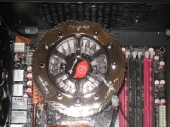Installation
Installation wasn’t hard thanks to easy to use push-pins. The brackets that have the push-pins must be installed on the cooler itself. The reason is that it has several different brackets because of wide coverage of processor sizes. After installing the brackets I applied the thermal paste that was included. I like to use the cross method which seems to spread the thermal paste more across the whole processor instead of a central circle.
The cooler itself did not overlap on any essential part on the motherboard. Unfortunately, it did overlap over the CPU Fan power supply that is on the motherboard at it was nearly impossible to plug it in. On the other hand the motherboards power supply for the fan did not provide enough power so I had to use PSU for it.
Testing
Test Rig:
Motherboard: Jetway BI-600 x58
CPU: Intel i7 920 (OC: 3.2GHz)
Video: ATi HD5870
Case: Element S with 120mm, 140mm, 230mm fans.
PSU: CoolerMaster SilentProM 600W
| SpinQ VT | ||
| 1000RPM | 1600RPM | |
| Boot | 29°C | 29°C |
| Idle | 38°C | 36°C |
| Bioshock 2 | 42°C | 40°C |
| 100% | 48°C | 45°C |
Conclusion
Thermaltake’s SpinQ VT brought some differences to their original design. Different material and different structure. The tests show that it definitely can hold it’s own. With an overclocked CPU the temperature’s stayed in a low range. Considering that i7 920 is in a safe zone below 80°C and a maximum temperature never crossed 50°C at 1000RPM, full load and overclocked CPU to 3.2GHz, I say the results are very good. To sum up, this is the type of cooler I’d be safe with when overclocking my CPU, it looks impressive but the price is in medium to high range it is pretty robust so you must see whether your motherboard has the right design for this cooler to fit properly.
Thermaltake SpinQ VT does everything it has to do, and does it well.


very impressive the spiral aluminum fins sound effective